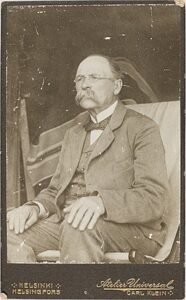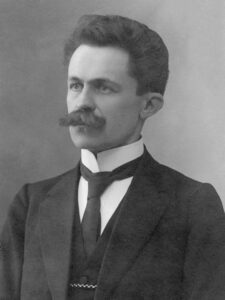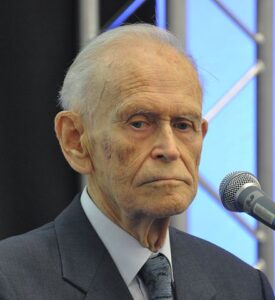By Ole Granholm, 2004.
Translated by June Pelo.
Johannes Granö felt the urge to travel to Siberia in the fall of 1880 after he met Pastor Udelius who worked at the county jail in Åbo. Udelius had suggested that Granö go to Siberia and take charge of the destitute and abandoned people. In the summer of 1885 Johannes, his wife Alma, nee (no) Fontell, and two minor-age children traveled to Omsk, Siberia, which became their headquarters. One can wonder why a Lutheran priest would leave secure employment in his homeland for work in a foreign country. In the Åbo jail Granö had met a deported runaway who told him of the terrible conditions for Finlanders in western Siberia. That influenced his decision to travel to the unknown.
 Johannes Granö
Johannes Granö
Attribution: Atelier Universal, CC BY 4.0
<https://creativecommons.org/
That’s how pastor Johannes Granö, who was born and grew up in Granö village in Terjärv, decided to work as a spiritual advisor for deported prisoners. The post had been vacant since 1879 but had no applicants. Earlier the Church had sent spiritual guides on a temporary basis but needed someone there permanently.
Siberia had long been a place of exile for prisoners of all types, including Finlanders who were imprisoned there. In Borgå in 1809 there was a proposal to banish Finlanders, but deportation had first begun when several prisoners, sentenced to death, were pardoned and sent to Siberia. During the autonomous times, 3,321 Finlanders were banished. Among those who were deported, most of them were Osterbottningar who had been pardoned from death sentences. Instead of being put behind bars, they were given the choice of being sent to Siberia. Most of them were males, but there were some women who had been sentenced for infanticide.
At the end of the 1800s some people who weren’t sentenced for a crime also went to Siberia with the hope of a better life and work as railroad workers. The Trans-Siberian railroad was completed in 1893 and Finlanders were still going to Siberia in the early 1900s.
Not all prisoners who chose to migrate were approved. The well-behaved prisoners were allowed to travel over 4,000 km to their place of exile. When their term of punishment was served, the Crown gave them land to cultivate and a little initial capital, and they had a chance as a foreign national to seek employment in some venture in Siberia.
Johannes Granö was born in 1850 in Terjärv. As an 18-year-old he became one of the first farmer students to study theology in Uleåborg and Åbo. After his ordination in 1877 he served a short period in Lappo and Kimito. In 1893 Granö wrote a book “Sex år i Siberia” (Six Years in Siberia). He had served 17 years in Siberia, but the book covers only his first period in the country.
His work territory covered practically all of Siberia from the Ural Mountains to the other side of the Baltic Sea. It is 4,000 km between Granö village in Terjärv and Omsk, Siberia. Transportation was limited. Before the Trans-Siberian railway was completed, the methods to get around were boats along the large rivers, horse-drawn carriages, and “shank’s mare”.
The villages consisted of rundown, ramshackle houses, and outbuildings on the musty smelling marsh. About 2,000 people lived there. Thefts, fights, and lewdness were the business of the day, and drunkenness was a terrible vice.
During the many long trips, Johannes had contact with all types of people. After a while he received permission to appoint his brother Anders as a teacher and policeman, and he served as a cantor at church services. Johannes was active in developing the region. Schools were built and he made sure there were books and newspapers. Many pubs were closed, and illicit distilling was shut down. He built a modest log house for his family. He traveled around the area, held church services, performed marriages and baptisms, functioned as a priest for prisoners and in the hospital, and made home-visits. He was both a school organizer and a farmer. In addition to this, he was a priest for Estonian and Latvian congregations in Omsk. There was also a large German colony in Omsk and many from Ingermanland. (Ingria, or Ingermanland, is the historical province between Estonia and Finland, in the vicinity of the present St. Petersburg.)
After serving six years in Siberia, Johannes returned to his homeland and was installed as a pastor at the Nedertorneå congregation. In 1901 he was elected as a priest representative in the Diet. The following year he returned to Siberia and worked there until 1913. In a letter dated 20 May 1904, he wrote about the Russian war far to the east. “In Omsk there were 40,000 soldiers and Cossacks. (Cossacks were a semi-nomadic and semi-militarized people, who, while under the nominal control of various Eastern European states at the time, were allowed a great degree of self-governance in exchange for military service.) We had seven men and two horses. Yesterday they went to the war. We have it warm here. Today it is 40° in the sun.”
On 1 Feb. 1905 he wrote a letter to Terjärv
Dear Emil,
Thanks for your letter I received some time ago, but I have had much work and a lot of travel, so I haven’t written. We are well and healthy. Soon I’ll begin my travels. Last year I traveled 13,000 verst. Often, I have traveled 100 miles by horse. At times I have been on a boat on the river, sometimes on the railroad. In the summer I live at our country place where there is a river and many fish, and we fish all day. I shall send you a picture from there. You can see Uncle Anders who just went for a swim in the river. In the other picture we and our guests sit in the yard in Omsk. (Omsk is a community in southwest Siberia) Did you paint your cottage? When I get old, I’ll build a cottage next to your place.
Many greetings to mamma and pappa, Sandvik Anders, Mathilda, Gambestu Matts, Risbacka men and everyone I know.
God be with you and everyone
Your Uncle Johannes Granö
But Johannes Granö never built the house he mentioned in the letter. He died 1913 just as he was planning to return to his homeland.
Johannes Gabriel (J. G.) Granö
Johannes’ son, Johannes Gabriel was born two years before the family moved to Siberia. When his father was installed as pastor in Nedertorneå, son Johannes Gabriel continued his schooling in Finland. He was a student from Oulu Academy and assistant at Helsingfors University.

Johannes Gabriel Granö
Attribution: Heinrich Riedel, Public domain, via Wikimedia Commons
During 1906-09 J. G. Granö went on a scholarship exploration expedition to Mongolia. After that he published his own doctor’s thesis and was installed as a docent with Helsingfors University. He took several trips to the Orient. His book ‘Altai’ was re-issued as a new edition later by Suomalaisen Kirjalllisuuden Seura. (The word ‘Altai’ refers to a bright white star in the constellation Aquila. It is the 12th brightest star in the night. It is unknown if the author intended to describe his book with this image.)
He spent the summers in Siberia. It is understandable that the interest of this newly appointed scientist should concentrate around those summer visits. It awakened in him an interest in future research in geography. In the spring of 1906, he received an invitation from the Finno-Ugric Society to travel to northern Mongolia on a scholarship. He later made two trips between 1907 and 1909.
He traveled over 6,000 km by horse. He had a talent for drawing and in his journal, he sketched the stone inscriptions he found. He was also a good photographer. He and his wife moved to Omsk where he built a house on the vacant land belonging to the Finnish priest. Then he accepted a position as professor at the university in Tomsk. (Tomsk is a community in central Russia.) His knowledge of languages came from the time he spent in Siberia. He spoke Finnish with his father and Swedish with his mother but went to a Russian school. The German influence in Omsk added to his knowledge and during his childhood he spoke four languages, learning French later.
In Dorpat, Estonia he organized and led an extensive research project in cooperation with archeologists and historians. He also started scientific research in Estonia. After three years in Dorpat, he returned to Finland as editor for the third edition of “Atlas of Finland”, and was also a professor of geography at Helsingfors University. He was principal at Åbo University and later became Chancellor. His knowledge of languages and of the world, as well as his sense of diplomacy, resulted in an invitation to be Finland’s ambassador in Stockholm during World War I. But he turned down the invitation, referring to his research. He died in 1956.
Olavi Granö
Olavi was born 1925 and worked as supervisor at Skärgardens research establishment for over 20 years. (A skärgard is an archipelago; a group of islands.) Olavi was a member of Finland’s Academy which is a central organization for science administration. He was awarded the academic title in 1980.
 Olivi Grano at the Turku Book Fair in 2011.
Olivi Grano at the Turku Book Fair in 2011.
Attribution: Soppakanuuna, CC BY-SA 3.0
<https://creativecommons.org/
-
-
- Environment and Land Use in the Shore Zone of the Coast of Finland
- The Duration of Shore Exposure along the Emerging Finnish Coast
-
The Institutional Structure of Science and the Development of Geography as Professional Practice
-
Oliva Granö died on 19.4.2013.